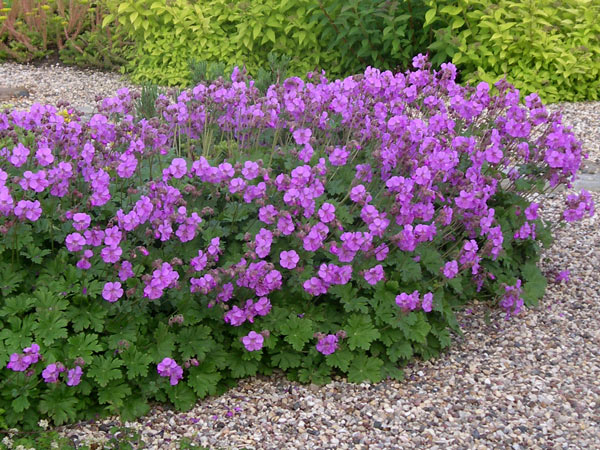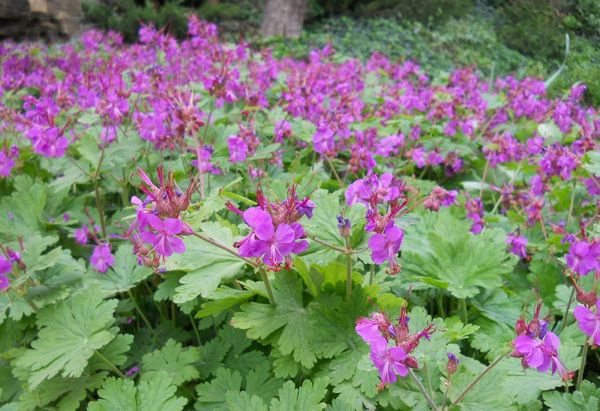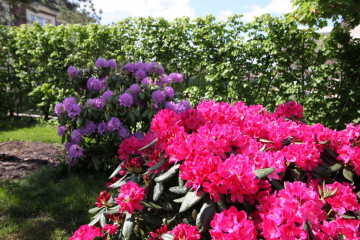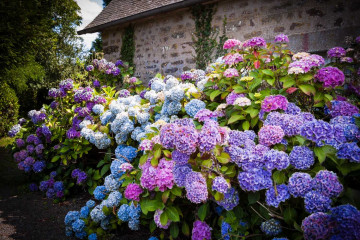Perennial garden geranium - planting and care in the open field
Content:
Perennial garden geranium belongs to the flowering plants from the Geraniev family. It is a popular, unpretentious and attractive garden plant. Thanks to its variegated flowers and long flowering period, many gardeners use this plant in landscaping. This flower will brighten any garden or yard.
The origin of the garden geranium
South Africa is considered the birthplace of perennial geranium. This flower was introduced to Europe in the 17th century. At the beginning of the 18th century, it came to Russia, and in the middle of the 19th century, many aristocrats began to grow it as a garden plant.
Thanks to the efforts of breeders, more than 400 species of geraniums have been bred, they differ in color and shape of flowers.
Descriptions and appearance
Garden geranium is a herbaceous, winter-hardy, well-branched shrub, the height of which varies from 10 to 125 centimeters. The bush keeps its shape well and does not need shaping. The leaves have a highly cut shape. Their color, depending on the species, is silver, light green or dark green. Leaves are both small and very large.
A perennial plant has thin and brittle stems that can be easily damaged by a strong gust of wind or heavy rain.
Geranium buds are located on the stems in several pieces and are often collected in inflorescences. Flowers are simple and double. On average, the size of a flower reaches 5 cm in diameter. The corolla is painted in a wide variety of colors. There is a hybrid geranium with white, pink, lilac-pink or blue flowers, and there is also an orange kind of flower.
The plant tolerates frost and dry weather remarkably, has good resistance to various diseases. The plant does not suffer from weeds, retains an attractive appearance even during the dormant period, when it does not bloom.
Types and varieties of perennial garden geranium
These types of garden geraniums are considered the most popular among gardeners.
Balkan
It has a powerful and long rhizome. Growing up, perennial rhizome geranium can form real thickets.
The flowers of this species are reddish or purple in color. The size of the flowers is not very large - when unfolded, their diameter is no more than 3 centimeters. The height of the bush does not exceed 30 centimeters. The flowering period begins in early June and lasts for one month.
The most popular varieties of the Balkan geranium are: tree-like Insversen, Spessagt and Variegata.
Blood Red
Flowers of this species are simple and double, in appearance they are very similar to garden roses. Geranium red-brown can bloom and grow profusely without transplanting for more than 10-12 years.When growing, the plant is very demanding and needs to follow all the rules of care.
Geranium sanguineum is preferable to plant in partial shade, but it will also grow well in sunny areas, only then you will have to water it more often. The soil for planting this variety should be slightly alkaline or neutral.
Swamp
It has medium-sized purple flowers, branched and erect stems, growing up to 70 centimeters in height.
The shrub is quite dense and not very large. It begins to bloom in June.
Georgian
This type of bush geranium is characterized by unpretentious care, resistance to temperature extremes and drought.
Flowers of this species have a purple color, during flowering they completely cover the entire bush.
Undersized
This type of geranium is especially popular with landscape designers. This plant is good because it is small - the bush grows up to 15 centimeters in height.
The flowers of this geranium are lilac-pink, small - no more than 3 centimeters in diameter. The leaf plates of the flower are colored gray-green. Flowering lasts from early July to late August.
Creeping
Ground cover geranium has thin roots and graceful dissected leaves with small petioles.
The flowers are pale pink in color, have an amazing aroma. The flowers are no more than 3 centimeters in size. The flowering period begins in early June and lasts until the end of September.
This creeping geranium looks very beautiful. After the first frost, the leaves acquire a pink-red hue and soon dry up and fall off.
Among all varieties of creeping geraniums, the most popular is Patracia garden geranium, whose flowers usually have a pale pink color, it looks very beautiful on flower beds and alpine hills, as well as the Blue Blood variety - a blue geranium with a purple tint.
Geranium in landscape design
When mixed planting in flower beds and alpine hills, the flower goes well with other flowering and evergreen plants. Creates a background and supports other lodging-prone flowers. Perennial geranium is considered a versatile plant for the garden; garden and landscape designers love it.
To create a beautiful border around a flower bed or garden path, gorgeous geranium will do. To create attractive speckled spots on the garden lawn, it is better to use a small-flowered garden geranium, it will look like a ballerina. Blood-red geraniums will look beautiful on the outskirts of shrub plantings. This look will look organic in the orchard.
Perennial geranium in the garden is an irreplaceable plant, its many types make it possible to choose the ideal plant for each individual case.
The plant is remarkably combined with various perennials and other "inhabitants" of the garden, it is perfect for neighbors:
- asters,
- primroses,
- roses,
- host and others.
Transplant after purchase in open ground
After acquiring a perennial garden geranium, it must be properly planted in a permanent place of growth - in open ground. To do this, you need to choose the right place and prepare the land.
Site selection and land preparation
Garden geranium grows well in well-lit places, but it will also feel great in places shaded by other shrubs.
Outdoor garden geranium does not impose any special requirements for the composition of the soil - the main thing is that it is well-drained and breathable.
The site for planting must be dug up a few days before planting. Rotted peat, compost and some sand must be added to the soil.
Landing
The process of planting geraniums step by step:
- The planting hole must be dug 15-20 centimeters deeper than the length of the roots of the seedling.
- Lay a layer of expanded clay, gravel or small stones at the bottom of the planting hole.
- Pour a layer of nutrient mixture in the form of a slide on the drainage layer.
- Place the plant vertically, spread the roots well over the entire surface of the earth.
- Sprinkle with garden soil and lightly tamp the soil around the stem.
- Water the bush well, and mulch the ground around.
- When planting young shoots, it is worth adhering to a distance between the bushes of at least 40 centimeters for tall varieties and at least 25 cm for undersized ones.
Geranium propagation
Garden geraniums propagate very easily by growing seedlings from seeds.
Growing from seeds
Planting seeds and growing seedlings step by step:
- Collect fresh geranium seeds or buy ready-made ones at a flower shop.
- Sow in a seedling pot filled with nutritious soil consisting of peat and sand.
- Water the plantings and cover with cling film.
- Provide an air temperature of at least +25 degrees and timely watering.
- When shoots appear, the temperature must be lowered to + 20-22 degrees.
- When two or three true leaves appear, the plants must be transplanted into separate pots.
- It is possible to land on the street only when the flower gets stronger and grows up to 10-15 cm in height.
Care
Despite its undemanding care, the flower blooms more magnificently and more abundantly, if it is given proper attention.
- Watering mode
The perennial is watered regularly, as the top layer of the earth dries up. Young plants especially need frequent watering.
During dry periods, watering should be frequent (2-3 times a week). If the plant grows in bright sun, and during the period of its activity the leaves droop heavily, after abundant watering they will quickly regain their shape.
- Top dressing
There will be an undoubted benefit if you apply mineral fertilizers during the active growing season. For good growth of the bush and bright green foliage, spring feeding is carried out with a liquid mullein or diluted humus.
- Perennial care during the flowering period
When the plant blooms, timely removal of faded buds is carried out - this will make it possible to bloom with new ones. Periodically, it is necessary to loosen the soil and remove weeds.
Once a month, it is important to carry out preventive treatment with fungicides - this will help protect the plant from possible diseases. Change the layer of mulch around the bushes every two weeks.
- Features of care during the rest period
During the rest period, preventive pruning of the bushes is carried out - yellow, dry leaves, dead side shoots and broken stems are cut off. This will heal the bush and encourage more vigorous growth.
Preparing for winter
Most types of garden geraniums have good frost resistance and therefore can easily winter without additional cover for the ground part of the plant. However, some care measures will still need to be carried out.
In the fall, when the bush wilts and dries up, remove all aerial stems and leaves. To protect the roots from possible freezing, thick-layer mulching is carried out using organic components - garden compost, sawdust, tree bark, pine needles, and dry mullein.
By planting perennial geraniums in the garden, you can get a rather unpretentious and beautiful flower that is beautiful not only in itself, but also in combination with other garden plants. With it, you can decorate any flower garden, front garden, garden or summer cottage.
























